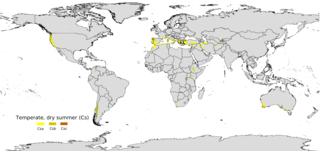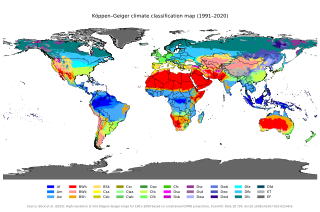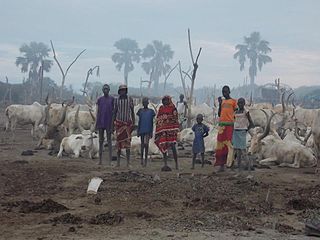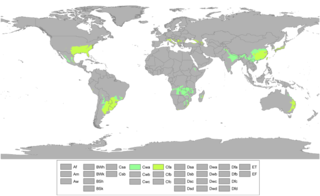
A Mediterranean climate, also called a dry summer climate, described by Köppen and Trewartha as Cs, is a temperate climate type that occurs in the lower mid-latitudes. Such climates typically have dry summers and wet winters, with summer conditions being hot and winter conditions typically being mild. These weather conditions are typically experienced in the majority of Mediterranean-climate regions and countries, but remain highly dependent on proximity to the ocean, altitude and geographical location.

The subtropical zones or subtropics are geographical and climate zones immediately to the north and south of the tropics. Geographically part of the temperate zones of both hemispheres, they cover the middle latitudes from 23°26′09.7″ (or 23.43603°) to approximately 35° north and south. The horse latitudes lie within this range.

Tropical climate is the first of the five major climate groups in the Köppen climate classification identified with the letter A. Tropical climates are defined by a monthly average temperature of 18 °C (64 °F) or higher in the coolest month, featuring hot temperatures and high humidity all year-round. Annual precipitation is often abundant in tropical climates, and shows a seasonal rhythm but may have seasonal dryness to varying degrees. There are normally only two seasons in tropical climates, a wet (rainy/monsoon) season and a dry season. The annual temperature range in tropical climates is normally very small. Sunlight is intense in these climates.

The Köppen climate classification divides Earth climates into five main climate groups, with each group being divided based on patterns of seasonal precipitation and temperature. The five main groups are A (tropical), B (arid), C (temperate), D (continental), and E (polar). Each group and subgroup is represented by a letter. All climates are assigned a main group. All climates except for those in the E group are assigned a seasonal precipitation subgroup. For example, Af indicates a tropical rainforest climate. The system assigns a temperature subgroup for all groups other than those in the A group, indicated by the third letter for climates in B, C, D, and the second letter for climates in E. For example, Cfb indicates an oceanic climate with warm summers as indicated by the ending b. Climates are classified based on specific criteria unique to each climate type.
Yola, meaning 'Great Plain' or 'Vast Plain Land', is the capital city and administrative centre of Adamawa State, Nigeria. It is located on the Benue River, and has a population of over 336,648 (2010). Yola is split into two parts. The old town of Yola where the Lamido of Adamawa resides, is the traditional city and the new city of Jimeta is the administrative and commercial centre.
The climate of Mumbai is tropical, with defined wet and dry seasons. The mean annual temperature is 27.7 °C or 81.9 °F. Average annual rainfall is 2,213.4 millimetres or 87 inches in Colaba, which represents South Mumbai and 2,502.3 millimetres or 99 inches in Santacruz, which represents central and suburban Mumbai. The mean maximum average temperatures is about 32 °C (90 °F) in summer and 30 °C (86 °F) in winter, while the average minimums are 26 °C (79 °F) in summer and 18 °C (64 °F) in winter. The city experiences a lengthy, practically rainless dry season, and a relatively short, but extremely rainy wet season; due to the Southwest Monsoon and orographic influences from the nearby Western Ghats.These conditions effectively place Mumbai between a Tropical monsoon climate (Am) and a Tropical savannah climate (Aw), with more tilt towards the former considering annual precipitation.

An oceanic climate, also known as a marine climate or maritime climate, is the temperate climate sub-type in Köppen classification represented as Cfb, typical of west coasts in higher middle latitudes of continents, generally featuring cool to warm summers and cool to mild winters, with a relatively narrow annual temperature range and few extremes of temperature. Oceanic climates can be found in both hemispheres generally between 40 and 60 degrees latitude, with subpolar versions extending to 70 degrees latitude in some coastal areas. Other varieties of climates usually classified together with these include subtropical highland climates, represented as Cwb or Cfb, and subpolar oceanic or cold subtropical highland climates, represented as Cfc or Cwc. Subtropical highland climates occur in some mountainous parts of the subtropics or tropics, some of which have monsoon influence, while their cold variants and subpolar oceanic climates occur near polar or tundra regions.
Sarh, formerly French colonial Fort Archambault, is the capital of the Moyen-Chari Region and the capital of the Department of Barh Köh in Chad.

Barinas is a city in west central Venezuela. According to the 2011 census, its population is 353,442. It is the capital of the Barinas Municipality and the State of Barinas. The city of Barinas is known as the capital of the Llanos.

Rumbek is the capital of Lakes State in the Bahr el Ghazal region of South Sudan.

Malakal is a city in South Sudan, serving as the capital of Upper Nile State in the Greater Upper Nile region of South Sudan, along the White Nile River. It also serves as the headquarter of Malakal County and it used to be the headquarter of Upper Nile Region from the 1970s to the late 1990s.

Wau is a town, locally referred to as a city, in northwestern South Sudan on the western bank of Jur River It is the capital of Western Bahr el Ghazal region in South Sudan. It lies approximately 650 kilometres (400 mi) northwest of the capital, Juba. It is a diverse small urban center (town) and a trading hub. The city has been a municipality since 2012 and is governed by a mayor who the state governor usually appoints. The city comprises several neighborhoods including Nazareth, Hai Fahal, Sika Hadid, and Daraja.
The climate of Bismarck in the U.S. state of North Dakota is humid continental, caused primarily by the combination of its mid-level latitude and location not far from the geographic centre of the U.S. Its summers are hot enough for it to border on having a Köppen Dwa classification, and precipitation is high enough for it to barely avoid being classified as semi-arid. The city's climate displays four very distinct seasons and great variation in temperatures over very short periods of time. Like other cities in the northern Great Plains, its climate is also fairly dry.

Cruzeiro do Sul is a municipality located on the Juruá river in the west of the Brazilian state of Acre. It is the second-largest city in Acre.
The climate of San Diego, California, is classified as a hot-summer Mediterranean climate. The basic climate features hot, sunny, and dry summers, and cooler, wetter winters. However, San Diego is much more arid than typical Mediterranean climates, and winters are still dry compared with most other zones with this type of climate. The climate at San Diego International Airport, the location for official weather reports for San Diego, as well as the climate at most beach areas, straddles the border between BSh and BSk due to the mild winters and cool summers in these locations.

The climate of the United States varies due to changes in latitude, and a range of geographic features, including mountains and deserts. Generally, on the mainland, the climate of the U.S. becomes warmer the farther south one travels, and drier the farther west, until one reaches the West Coast.

A humid subtropical climate is a subtropical-temperate climate type, characterized by long and hot summers, and cool to mild winters. These climates normally lie on the southeast side of all continents, generally between latitudes 25° and 40° and are located poleward from adjacent tropical climates, and equatorward from either humid continental or oceanic climates. It is also known as warm temperate climate in some climate classifications.

An area of tropical monsoon climate is a tropical climate subtype that corresponds to the Köppen climate classification category Am. Tropical monsoon climates have monthly mean temperatures above 18 °C (64 °F) in every month of the year and a dry season. The tropical monsoon climate is the intermediate climate between the wet Af and the drier Aw.

Cyprus has a subtropical climate, Mediterranean and semi-arid type according to Köppen climate classification, with very mild winters on sea level and warm to hot summers. Snow is possible only in the Troodos Mountains in the central part of the island. Rain occurs mainly in winter, with summer being generally dry.
The Roman Catholic Diocese of Guasdualito is a young Latin Catholic suffragan diocese of the Metropolitan Roman Catholic Archdiocese of Mérida in Venezuela in southern Venezuela's land-locked Apure State.
















